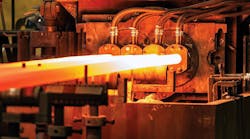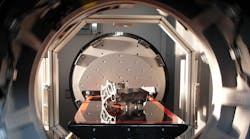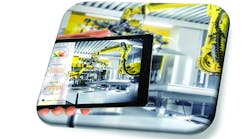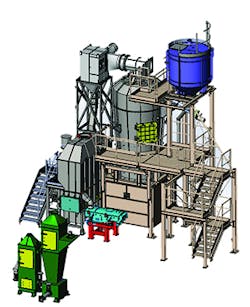No industrial conference is complete now without some discussion of the Internet of Things (or, Industry 4.0), but typically these presentations are focused on the emergence or advancement of product traceability. For metalcasting, this is a narrow understanding of the potential of IoT, according to FATA Aluminum, which designs plants and machinery for gravity casting and systems for regenerating foundry sand. Now, FATA Aluminum has developed and introduced it’s own vision of IoT/Industry 4.0 for metalcasting, which it calls the Foundry of the Future.
The Foundry of the Future (FoF) proposition is based on “intelligent connectivity,” meaning it will automatically anticipate and avoid downtime, thus increasing production volume and achieving the flexibility to adapt to new customer requirements.
Individual components that combine mechanical, electrical, and computer engineering (i.e., "mechatronics") have been used in production before now, but these devices take on new significance via the interconnection and communication functions of IoT.
What makes it possible to coordinate their functions is the more powerful computing capability of Cloud-based super-computers, which quickly analyze ever increasing and variable data volumes, and still deliver conclusions in real-time. This data-management capacity makes possible effective self-correction, predictive maintenance, and energy management, so metalcasting processes can be more fully optimized, and operating costs can be lowered.
Previously, the only way to maintain competitive costs was to push systems beyond their productive limits, according to FATA Aluminum. Now, the benefits of interconnectivity can be anticipated:
• Long-term product quality standards, thanks to statistical analysis and control of multiple parameters and process trends;
• Data analysis to monitor “severe” operating parameters for machines and systems, increasing availability and optimizing preventive/predictive maintenance;
• Full product traceability, fulfilling customers’ part quality and safety requirements.
FATA Aluminum’s FoF development is a “simple and self-configuring” IT application tool (i.e., an “app”) that helps to achieve these benefits. FATA FoF was designed for end-users, drawing on the group’s knowledge base of aluminum casting processes and systems. Using the app, metalcasting operators can coordinate “mechanical, fluid dynamics and electrical design into a single technology,” according to the developers.
There are additional advantages to real-time, analytical control of KPIs: Such a system can automatically advise what corrective or proactive actions to take for process deviations, or someone with more expertise can act to avoid a remote location production crisis. Further, it will allow the most talented or experienced process personnel to take immediate action, to technically support remote locations, magnifying the value of that expertise across an organization.
Energy consumption would be one KPI worth optimizing, but FATA points to another potentiality: improved environmental management. For example, the organic resins used in core production may result in noxious odors released outside the plant. Even if the traditional emission treatment and abatement systems are well managed, the odors are beyond the control of in-plant air ventilation and exchange.
Even if foundry exhaust-air treatment is done on a schedule, the results will be influenced by factors like atmospheric conditions and the number of machines in production, which hinder emissions management. “Maintaining negative pressure inside a plant is the only way to contain or eliminate the spread of emissions under all possible operating conditions,” FATA noted, adding that most metalcasting plants do not do that.
Drawing on the expanded data analysis made possible by connectivity, FATA Aluminum is able to evaluate and map the “untreated emissions” that escape into the air around the plant. These results can inform strategies for diminishing the spread of emissions.
FATA Aluminum proposes air pollution treatment that is low in capital investment and has low operating costs, based on proven technologies and applied to aluminum foundries that use biomass fluid beds. (Such systems can be engineered for new foundries, or those seeking to adopt a more eco-friendly process.) The net effect is no environmental impact, as biomass transforms polluting molecules into CO2.










